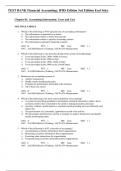Tentamen (uitwerkingen)
Test Bank Financial Accounting: IFRS Edition 3rd Edition by Earl Stice;Steve Albrecht;Monte Swain;Audrey Hsu. Isbn.9789814962582.
- Vak
- Instelling
Test Bank Financial Accounting: IFRS Edition 3rd Edition by Earl Stice;Steve Albrecht;Monte Swain;Audrey Hsu. Isbn.9789814962582. Financial Accounting, IFRS Edition, Third Edition Test Bank. Financial Accounting 3e Test Bank. PART I: FINANCIAL REPORTING AND THE ACCOUNTING CYCLE ; PART II: OPERATI...
[Meer zien]




